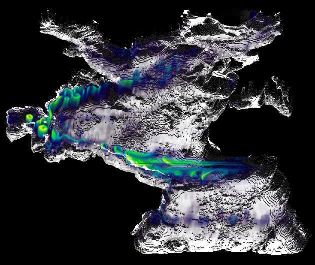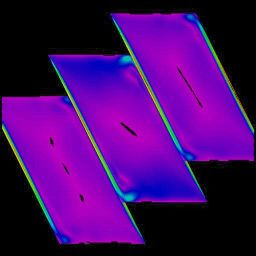A Parallel Volume Rendering System for Scientific Visualization
Objective:
Develop a portable and scalable parallel volume rendering system for the
teraflop supercomputers to support
distributed visualization needs demanded by HPCC Grand Challenge applications
and general science community. The rendering system is capable of visualizing
large volumes of 4-D simulation/modeling data which are beyond that the
existing workstation capability and network bandwidth can handle.
Approach:
A parallel volume rendering Application Programming Interface
(API) based on the splatting algorithm was designed and implemented.
The API renders 3-D scalar and vector
fields in structured grids, in both time and space. An X-window based
GUI with multiple control panels was also designed and implemented for
interactive control of visualization
parameters and trackball control of viewing positions. A network interface was
built in between the GUI and the renderer API that supports image compression
over low-speed network and high-resolution displays such as HiPPI framebuffer
and Powerwall over high-speed network. All together, the distributed volume
rendering system is called the ParVox (Parallel Voxel Renderer).
Accomplishments:
The ParVox was first demonstrated in October 1997.
In FY'97, we continue the development and implementation of
the ParVox system. The major accomplishments include:

- Vector visualization -- we have tried several ways for visualizing
vectors, including Line Integral Convolution (LIC) and magnitudes.
Both methods convert vectors into scalars, then using scalar
rendering to look at the data. We found out LIC is not a very
intuitive way to visualize 3-D volumes; it is more effective if the
vectors can be mapped to a predefined surface. We also found out that
magnitude is a good representation for certain datasets. By
adjusting the voxel opacity based on the magnitude values, we are able to
visualize the eddy-resolving at Atlantic Ocean in the ocean velocity
datasets from the
Ocean Climate Modelling Project. The data was provided
Yi Chao, using the Parallel Ocean Program (POP).
A five-year ocean circulation animation was generated using
ParVox on the JPL Cray T3D. One still image from the animation is
shown in Figure 1.

- Slice visualization -- Plotting 2-D slices is a common way to look at
3-D datasets. We added a new feature in ParVox to enable
visualization of multiple slices along three major axes. A
new control panel was built in GUI to allow users to define up to 10
slices with designated opacities. A multiple-slice image rendered
using data from a 3D Thermal Convective Flow Model is shown in Figure 2. Data was provided by
Ping Wang.
- Color and opacity editing -- We integrated a color editing software,
Icol,
developed by Army High Performance Computing Research Center
(AHPCRC), in the ParVox GUI. It is a useful tool for interactive
editing and sketching color maps and opacity maps that are
interpolated between key points.
In addition, we wrote a technical paper,
ParVox -- A Parallel Splatting Volume Rendering System for
Distributed Visualization. This paper will be published in
the IEEE
Proceedings of Parallel Rendering Symposium, October 1997. A ParVox
home page will be available in the near future.
Significance:
The demand for parallel supercomputer in interactive scientific visualization
is increasing as the ability of the machines to produce large output datasets
has dramatically increased. The ParVox system provides a solution for
distributive visualization of large time-varying datasets on scientist's
desktop using low-speed network and low-end workstations.
Status/Plans:
The major plan for FY'98 is to port ParVox to MPI2.0. ParVox uses
asynchronous one-way communication routines in Cray's shmem library to
interleave the rendering and compositing, thus hiding the
communication overhead and improving the parallel algorithm's
efficiency. The MPI2.0 specification, announced in July '97, includes
a one-way communication API that is very similar to Cray's shmem
library. To minimize the porting effort and optimize the memory
access performance of the shared-memory MPP, which is becoming the
dominant architecture for the parallel supercomputers, we decide to
port ParVox to the MPI2.0. Currently, none of the supercomputer
vendors are supporting MPI2.0 yet, but we expect it will become available
soon. The second plan for the FY'98 is to provide functional
pipelining by separating the compression module from the rendering
module and building interface between the application program and the
ParVox. A fully pipelined ParVox distributed visualization system is
illustrated in Figure 3.
Point of Contact:
P. Peggy Li
Jet Propulsion Laboratory
(818)354-1341
peggy@spartan.jpl.nasa.gov

